In today’s digitally-driven culinary landscape, a restaurant’s online presence can be as vital as its signature dish. With an ever-growing number of food enthusiasts turning to search engines to discover their next dining experience, it’s crucial that SEO marketing for restaurants to ensure their establishment shines brightly in the vast digital arena. Enter Restaurant SEO: a strategic alchemy of techniques that enhances a restaurant’s online visibility, drawing in a steady stream of potential patrons. In this blog post, we’ll delve deep into the nuances of SEO for Restaurants, offering insights and actionable tips to plate up your establishment’s online profile, ensuring it’s as appetizing as the meals you serve.
How Can Restaurant SEO Help Your Business?
SEO, or Search Engine Optimization, is a digital strategy designed to improve a website’s visibility in search engines like Google. By enhancing online presence, SEO for restaurant website can drive more organic traffic, leading to increased footfall and sales. In the modern digital era, where diners often turn to the internet first for recommendations, having an optimized online presence is equivalent to having an inviting storefront in the physical world.
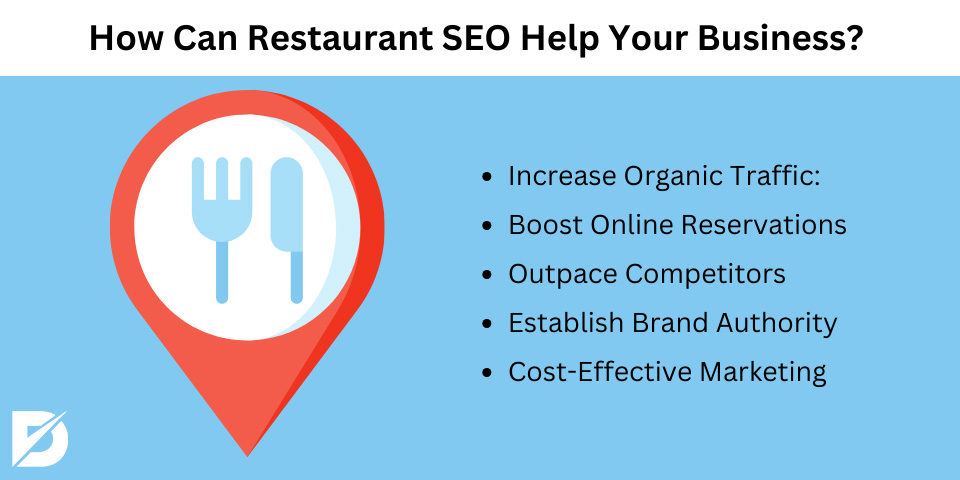
- Increase Organic Traffic: SEO can help increase the number of visitors to your restaurant’s website through organic search results.
- Boost Online Reservations: As your website becomes more visible in search results, you may notice an uptick in online bookings.
- Outpace Competitors: A well-optimized site can stand out among competitors, making your restaurant the first choice for diners searching online.
- Establish Brand Authority: SEO, combined with quality content, positions your restaurant as an authority in the food industry.
- Cost-Effective Marketing: Unlike paid advertising, SEO requires an initial investment but can yield long-term results without ongoing costs.
Why Is Restaurant SEO Important?
In today’s digital age, diners often begin their restaurant journey online, whether looking for a new place to eat, checking reviews, or making reservations. Ensuring your restaurant is easily discoverable online directly translates to more bookings and walk-ins. Plus, with the rise of delivery and takeout services, being prominently positioned in online searches can drive significant takeout revenue. In essence, SEO bridges the gap between your restaurant and potential customers.
- Local Searches: Many customers search for restaurants nearby. SEO ensures your restaurant pops up in these local searches.
- Mobile Users: With most searches coming from mobile devices, having an optimized site can make or break a potential customer’s experience.
- Changing Dynamics: As more people rely on online reviews and ratings, having a strong online presence can draw more customers to your restaurant.
- Online Orders: For restaurants offering takeout or delivery, SEO can dramatically increase order volumes.
7 Steps to Improve Your Restaurant SEO Visibility
The digital realm is expansive, and standing out can be challenging. However, by applying structured and targeted SEO tactics, your restaurant can shine brightly amid a sea of competitors. Let’s delve deeper:
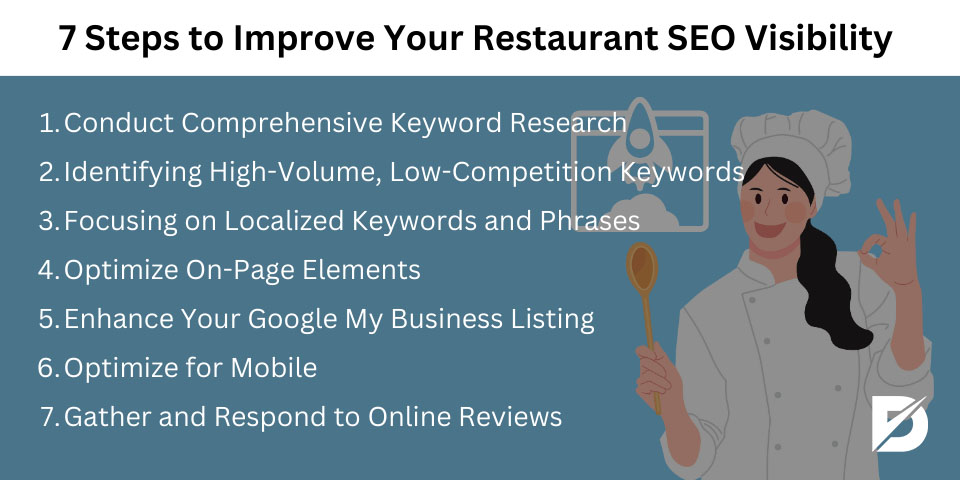
- Conduct Comprehensive Keyword Research: Every successful SEO strategy begins with keyword research. Understanding the terms your potential customers use when searching for dining experiences can shape your content and website structure, making it easier for them to find you.
- Identifying High-Volume, Low-Competition Keywords: Not all keywords are created equal. Targeting those that have significant search volume but fewer competing businesses vying for them can provide a quicker route to the coveted top spots on search engine results pages.
- Focusing on Localized Keywords and Phrases: Local SEO for restaurants is crucial. Potential diners often search with locality in mind, so tuning into terms that relate specifically to your area can yield rich rewards.
- Optimize On-Page Elements: The structure and content of your website play a significant role in SEO. From the meta descriptions to the imagery used, ensuring every element is optimized and relevant enhances the user experience and communicates the right signals to search engines.
- Enhance Your Google My Business Listing: This free tool from Google is invaluable for local businesses. An updated and active profile can not only improve your local search ranking but also provide potential diners with essential information like operating hours, location, and even a peek into your menu.
- Optimize for Mobile: With a significant chunk of searches and browsing happening on mobile devices, ensuring your website is responsive and mobile-friendly is paramount. A seamless mobile experience can also directly influence booking decisions.
- Gather and Respond to Online Reviews: Online reputation can make or break a restaurant in today’s digital age. Encouraging positive reviews and addressing any customer concerns not only improves online sentiment but also showcases your commitment to exceptional customer service.
SEO is a long-term strategy, and consistent efforts are required to maintain and improve your rankings.
Conduct Comprehensive Keyword Research
- Understand Your Audience: Before diving into keyword research, ensure that you have a clear understanding of your target audience and their dining preferences. This will help in selecting relevant keywords.
- Use Keyword Research Tools: Tools like Google Keyword Planner, SEMrush, and Ahrefs can help identify relevant keywords for your restaurant niche. These tools provide insights into search volume, competition, and other pertinent data.
- Analyze Competitors: Look at what keywords your competitors are targeting. This will give you an idea of the market trends and help you find gaps or opportunities.
- Stay Updated: Trends and preferences change over time. Make sure to revisit your keyword research periodically to stay up-to-date.
Identifying High-Volume, Low-Competition Keywords
- Filter Using Keyword Tools: Once you gather a list of potential keywords, filter them to identify ones with high search volume but low competition. These are golden opportunities.
- Consider Long-Tail Keywords: These are extended and more detailed keyword phrases that visitors use when nearing the decision to purchase. For instance, “vegan Italian restaurant in Brooklyn” might have less competition than “Italian restaurant.”
- Look For Questions or Queries: People often search for specific questions. Tools like Answer the Public can help identify these queries. For example, “Where can I find gluten-free desserts in Miami?” could be a potential long-tail keyword.
Focusing on Localized Keywords and Phrases
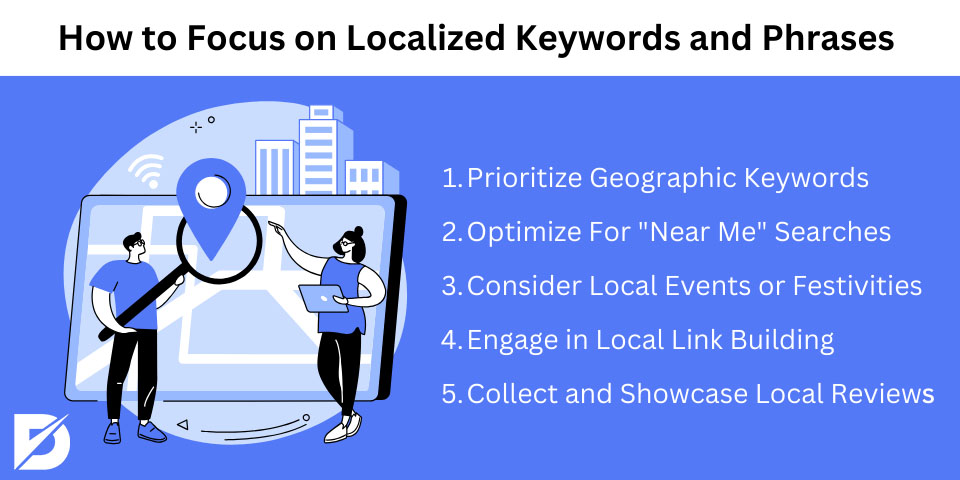
- Prioritize Geographic Keywords: Incorporate the name of your city, neighborhood, or landmarks nearby. E.g., “seafood restaurant near Central Park.”
- Optimize For “Near Me” Searches: Many people search for restaurants using “near me.” Ensure your restaurant is listed on Google My Business and other local directories.
- Consider Local Events or Festivities: If there’s a significant event or festivity in town, create content or offers around it and optimize with keywords related to that event.
- Engage in Local Link Building: Partner with local businesses or blogs to get backlinks. This can help increase your website’s authority in local search results.
- Collect and Showcase Local Reviews: Encourage satisfied customers to leave reviews on Google, Yelp, and other relevant platforms. Positive reviews with localized keywords can help boost your local search ranking.
By implementing these strategies, restaurants can optimize their online presence, attract more local customers, and stay ahead in the digital landscape.
Optimize Your Restaurant’s Website for Mobile Users
In today’s digital age, having a mobile-friendly website is no longer a luxury; it’s a necessity. With an ever-increasing number of consumers browsing and booking on mobile devices, optimizing your restaurant’s website for mobile users is paramount. This optimization ensures that diners can easily view your menu, make reservations, and find your location, all while on the move. The following strategies can help elevate the mobile user experience on your website.
The Importance of a Mobile-Responsive Design
A mobile-responsive design automatically adjusts to fit the device on which it’s viewed, be it a smartphone, tablet, or desktop. This adaptability ensures the content is easily readable and the navigation is intuitive regardless of the device’s screen size. Websites with mobile-responsive designs provide users with a seamless experience, reducing the likelihood of potential diners getting frustrated and bouncing off. Additionally, search engines like Google prioritize mobile-responsive websites in their rankings, which can enhance your restaurant’s visibility.
Speed Optimization for a Seamless User Experience
Page loading speed is crucial. Slow-loading websites can deter potential customers, with many users leaving a page if it doesn’t load within a few seconds. Speed optimization techniques such as reducing server response times, leveraging browser caching, and minifying code can drastically improve website performance. The quicker your restaurant’s website loads, the better the user experience, leading to higher engagement rates and potentially more reservations.
Simplifying Navigation for On-the-Go Diners
Mobile users often browse with a specific intention – finding a menu, booking a table, or getting directions. Thus, the navigation of your mobile website should be clear, concise, and easily accessible. Simplified menus, clear call-to-action buttons, and a search bar can significantly improve the browsing experience for on-the-go diners.
Prioritize On-Page SEO Elements
Search engine optimization (SEO) isn’t just about keywords; it’s about providing an excellent user experience. On-page SEO ensures your website’s content is relevant and accessible to search engines and users. This includes using descriptive URLs, optimizing header tags, and ensuring that keywords are naturally integrated into the content.
Crafting Compelling Meta Titles and Descriptions
Meta titles and descriptions provide a brief overview of what users can expect from your page. Crafting compelling meta tags can improve click-through rates from search results. For a restaurant, this might mean highlighting specialties, ambiance, or any unique selling points that might entice potential diners.
Implementing Schema Markup for Menus and Reviews
Schema markup is a form of microdata that helps search engines understand the content on your website. For restaurants, implementing a schema for menus ensures that search engines recognize and display them appropriately.
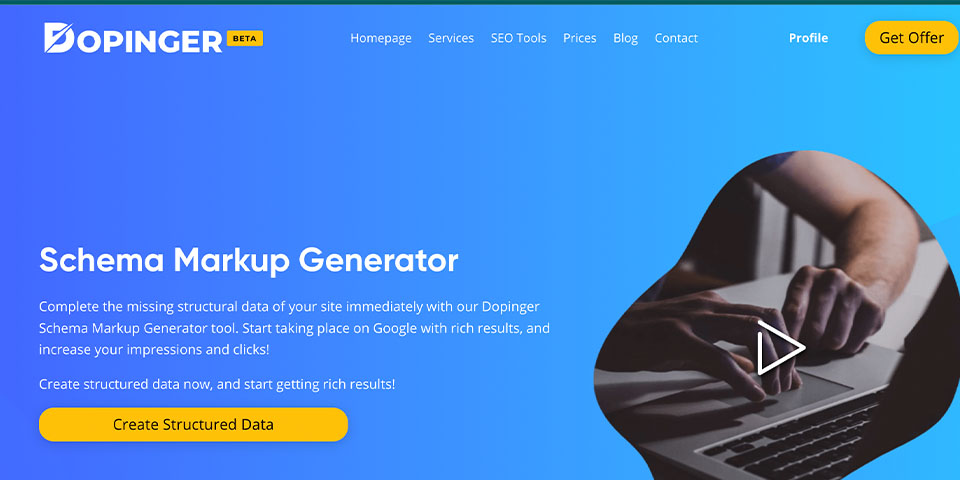
Similarly, a schema for reviews can highlight your restaurant’s rating directly in search results, building trust and attracting more diners. You can use Dopinger’s Schema Markup Generator.
Optimizing Images for Faster Load Times
High-quality images of your dishes can make your website visually appealing, but large files can drastically reduce page load speeds. Optimizing these images by compressing them without sacrificing quality ensures that they load quickly, maintaining a smooth user experience. Tools like JPEG Optimizer or TinyPNG can help compress images efficiently.
Optimizing your restaurant’s website for mobile users requires design, speed, and SEO strategies. Implementing these will not only improve the overall user experience but also drive more traffic and potential diners to your establishment.
Build Quality Backlinks and Local Citations
In the realm of SEO, backlinks act as votes of confidence from one website to another. Building high-quality backlinks from reputable sources can significantly boost your website’s authority and search rankings. For local businesses, especially eateries, local references (instances of your business name, address, and contact number on different websites) are vital in shaping local search standings. Ensure your restaurant is listed on local directories, community websites, and relevant industry portals. These citations not only improve your local SEO but also provide potential customers with more ways to find you.
Partnering with Local Food Bloggers and Reviewers
Collaborating with local food bloggers and reviewers can give your restaurant invaluable exposure. These influencers often have a loyal following that trusts their opinions and recommendations. By inviting them to review your restaurant or offering them a unique dining experience, you can tap into their audience and increase your restaurant’s online visibility. Furthermore, mentions and backlinks from their websites and social media platforms can enhance your SEO efforts.
Ensuring Consistent NAP (Name, Address, Phone Number) Across Directories
Consistency is vital for effective local SEO. Search engines use NAP data (Name, Address, Phone Number) to determine the legitimacy and relevance of a business. If your restaurant’s information is inconsistent across different directories and websites, search engines might get confused, leading to a drop in your local search rankings. Regularly audit your online presence and ensure your NAP data is uniform everywhere.
Encourage and Manage Online Reviews
Online reviews play a dual role: they influence potential customers’ perception of your restaurant and impact your local SEO restaurants. Encouraging satisfied customers to leave positive reviews can enhance your online reputation. Make it easy for them by providing direct links to your review profiles and subtly prompting them post-dining.
The Direct Impact of Reviews on Local SEO
Reviews have a direct correlation with local search rankings. Search engines view positive reviews as indicators of a business’s quality and relevance to users. A restaurant with numerous positive reviews is likely to rank higher than one with fewer or negative reviews. Moreover, the frequency, quantity, and diversity of the reviews are also taken into account. This makes it imperative for restaurants to continually gather and maintain positive reviews.
Responding to Feedback, Both Positive and Negative
It’s not enough just to receive feedback; responding to it is equally essential. Addressing both positive and negative reviews showcases your restaurant’s commitment to customer satisfaction. Thanking patrons for their positive remarks and addressing concerns raised in negative reviews can foster trust and loyalty among customers. Moreover, a proactive approach to handling feedback can mitigate potential damage from unfavorable reviews.
Incentivizing Happy Customers to Leave Reviews
While genuine reviews are always the goal, there’s no harm in incentivizing the process occasionally. Offering discounts, loyalty points, or even a simple thank-you note can motivate contented customers to share their experiences online. However, always ensure that the incentives do not bias the reviews. Transparency is key; let your customers know you value their honest opinions, regardless of their nature.
Create Valuable and Relevant Content
In the digital age, content remains king. It’s imperative for businesses, especially in the food and hospitality sector, to produce content that is both valuable and relevant to their target audience.
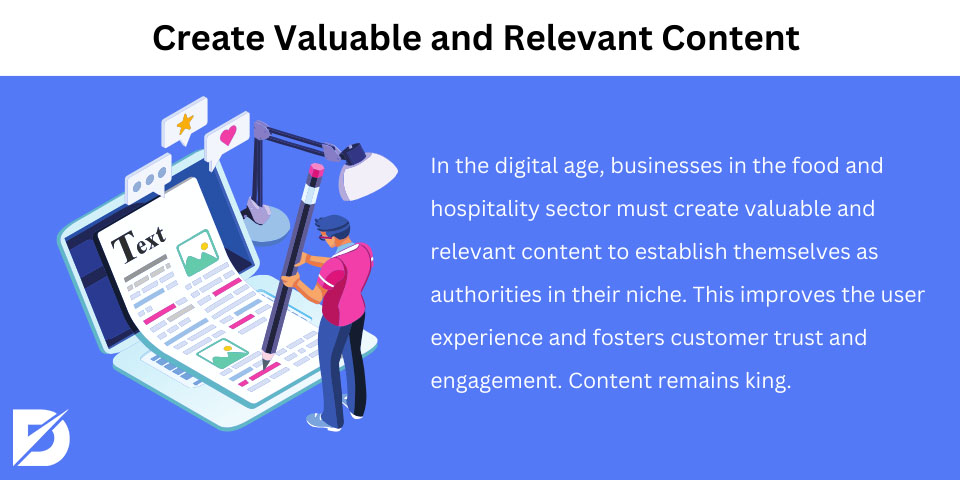
Not only does this help establish the business as an authority in its niche, but it also improves the overall user experience. Customers are likelier to engage with and trust a brand that offers insightful and helpful content tailored to their needs and interests.
Blogging About Unique Dishes, Events, and Promotions
A great way for restaurants and cafes to drive organic traffic to their website is by blogging about their unique dishes, upcoming events, and ongoing promotions. This not only provides customers with the latest updates about the business but also gives them a reason to visit the establishment. Blog posts highlighting a special dish or detailing an upcoming event can create buzz and anticipation, thereby enhancing customer engagement and loyalty.
Using Videos and Visual Content for Deeper Engagement
The power of visual content in capturing viewers’ attention cannot be understated. Videos, in particular, have emerged as a dominant medium for businesses to engage with their audience. Restaurants and cafes can leverage this by creating behind-the-scenes videos of the kitchen, showcasing the preparation of dishes, or even offering virtual tours of their establishment. Photos and infographics, on the other hand, can be used to highlight menu items, share customer testimonials, or depict the place’s ambiance. Such visual content not only enriches the user experience but also encourages deeper engagement with the brand.
Monitor and Analyze SEO Performance Regularly
To ensure that the digital marketing efforts of a business are effective, it’s crucial to monitor and analyze SEO performance regularly. By keeping a close eye on metrics like organic traffic, bounce rate, and conversion rate, businesses can identify which strategies are working and which need improvement. This proactive approach allows for quick adjustments and ensures that the business remains on the path to achieving its digital marketing goals.
Using Tools like Google Analytics and Search Console
To get a comprehensive understanding of website performance and user behavior, it’s essential to utilize tools like Google Analytics and Search Console. Google Analytics provides insights into user demographics, behavior, and conversion paths, while Search Console offers data on search queries, click-through rates, and website health. Together, these tools provide a holistic view of a website’s performance and areas needing attention.
Adapting to Changes in Search Algorithms and Trends
The digital landscape is ever-evolving, with search engines constantly updating their algorithms to improve user experience. For businesses to stay ahead of the curve and maintain a strong online presence, they must stay updated with these changes and adapt accordingly. This might mean updating website content, optimizing for new search trends, or even rethinking the entire SEO strategy. Staying agile and flexible in these changes ensures that a business remains visible and relevant in search results.
By creating valuable content, leveraging visual mediums, and staying updated with SEO trends, restaurants and cafes can significantly enhance their digital presence and connect with their audience more effectively.
Finally
In today’s digital age, where diners often turn to search engines before deciding where to eat, a robust online presence is indispensable for restaurants. Restaurant SEO is not just about gaining visibility but about connecting with the right audience at the right time. By optimizing website content, ensuring consistent local listings, leveraging reviews, and staying updated with search engine algorithms, restaurants can significantly boost their online discoverability. As competition in the culinary world continues to heat up, those who prioritize and implement effective SEO strategies will undoubtedly be the ones to savor the sweet taste of success.
Frequently Asked Questions About
Restaurant SEO refers to the specific strategies and techniques used to optimize a restaurant’s online presence for search engines. This ensures that when potential customers search for dining options or specific cuisines in your area, your restaurant appears prominently in the results. Given the increasing reliance on online searches for dining recommendations, effective SEO can significantly boost foot traffic, online reservations, and overall brand visibility.
SEO is a long-term investment, and results typically vary based on competition, the current online health of your website, and the strategies implemented. While some changes might result in noticeable improvements within weeks, most SEO strategies can take several months to yield significant results. Consistency and patience are key.
Absolutely! Search engines like Google consider online reviews and ratings when ranking businesses. Positive reviews can improve your restaurant’s online reputation and boost your search engine ranking. Encouraging satisfied customers to leave positive reviews, responding to feedback, and maintaining high service standards are essential to a comprehensive Restaurant SEO strategy.





No comments to show.